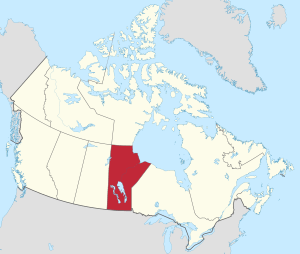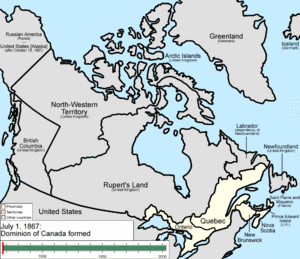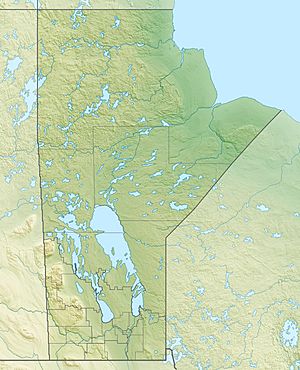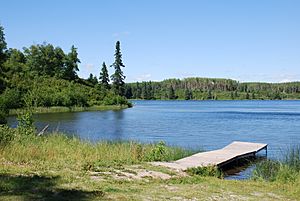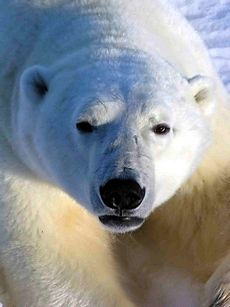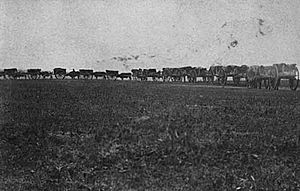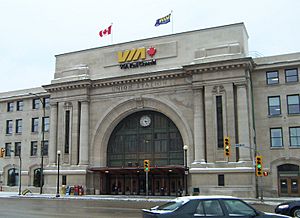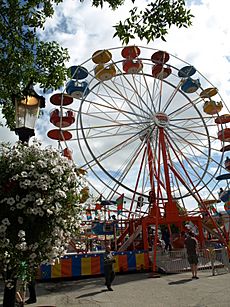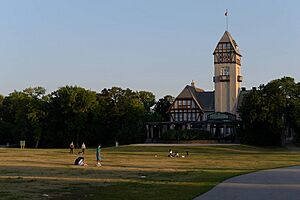Manitoba facts for kids
Quick facts for kids
Manitoba
|
|||
|---|---|---|---|
|
|||
| Motto(s):
Latin: Gloriosus et Liber
"Glorious and free" |
|||
| Country | Canada | ||
| Confederation | 15 July 1870 (5th, with Northwest Territories) | ||
| Capital | Winnipeg | ||
| Largest city | Winnipeg | ||
| Largest metro | Winnipeg Region | ||
| Government | |||
| • Type | Parliamentary constitutional monarchy | ||
| Area | |||
| • Total | 647,797 km2 (250,116 sq mi) | ||
| • Land | 553,556 km2 (213,729 sq mi) | ||
| • Water | 94,241 km2 (36,387 sq mi) 14.5% | ||
| Area rank | Ranked 8th | ||
| 6.5% of Canada | |||
| Population
(2021)
|
|||
| • Total | 1,342,153 | ||
| • Estimate
(Q2 2024)
|
1,484,135 | ||
| • Rank | Ranked 5th | ||
| • Density | 2.42/km2 (6.3/sq mi) | ||
| Demonym(s) | Manitoban | ||
| Official languages | English | ||
| GDP | |||
| • Rank | 6th | ||
| • Total (2015) | C$65.862 billion | ||
| • Per capita | C$50,820 (9th) | ||
| Time zone | UTC−06:00 (Central) | ||
| • Summer (DST) | UTC−05:00 (Central DST) | ||
| Rankings include all provinces and territories | |||
Manitoba (![]() i/ˌmænɪˈtoʊbə/ MAN-ih-TOH-bə) is a province located right in the middle of Canada. It is the fifth-most populated province in the country, with over 1.3 million people as of 2021. Manitoba has many different types of landscapes. In the north, you'll find arctic tundra and the Hudson Bay coastline. Further south, there are thick boreal forests, huge freshwater lakes, and wide-open prairie grasslands.
i/ˌmænɪˈtoʊbə/ MAN-ih-TOH-bə) is a province located right in the middle of Canada. It is the fifth-most populated province in the country, with over 1.3 million people as of 2021. Manitoba has many different types of landscapes. In the north, you'll find arctic tundra and the Hudson Bay coastline. Further south, there are thick boreal forests, huge freshwater lakes, and wide-open prairie grasslands.
Indigenous groups have lived in Manitoba for thousands of years. In the early 1600s, English and French fur traders started to arrive and set up small communities. The Kingdom of England took control of the area in 1673, creating a territory called Rupert's Land. This land was managed by the Hudson's Bay Company. Rupert's Land, which included all of modern-day Manitoba, grew from 1673 to 1869, with many Indigenous and Métis people living in the Red River Colony.
Talks to create the province of Manitoba began in 1869. However, there were big disagreements about the right to self-determination (the right for people to choose their own government). This led to a conflict called the Red River Rebellion between the Canadian government and the people of the Red River Colony, especially the Métis. After the conflict was resolved and more talks happened, Manitoba became the fifth province to join Canadian Confederation (Canada's union of provinces). This happened when the Parliament of Canada passed the Manitoba Act on July 15, 1870.
Manitoba's capital and largest city is Winnipeg. It is the sixth most populated city in Canada. Winnipeg is where the government meets, and it's home to the Legislative Assembly of Manitoba and the Provincial Court. Four of the province's five universities, all four of its professional sports teams, and most of its cultural events (like Festival du Voyageur and Folklorama) are in Winnipeg. The city has an international airport, as well as train and bus stations. A Canadian Forces base, CFB Winnipeg, operates from the airport and is an important military headquarters.
Contents
- What's in a Name?
- Manitoba's Story: A Journey Through Time
- Exploring Manitoba's Geography
- People and Places in Manitoba
- Manitoba's Economy: How People Make a Living
- Military Presence in Manitoba
- Getting Around: Transportation in Manitoba
- Learning in Manitoba: Education
- Manitoba's Culture: Arts, Festivals, and More
- Sports in Manitoba
- See also
What's in a Name?
The name Manitoba might come from two different Indigenous languages. It could be from Cree manitou-wapow or Ojibwe manidoobaa. Both of these phrases mean "straits of Manitou, the Great Spirit." Another idea is that it comes from the Assiniboine word minnetoba, which means "Lake of the Prairie." French explorers used to call the lake Lac des Prairies.
The name was chosen by Thomas Spence for a new republic he wanted to create south of the lake. Métis leader Louis Riel liked this name better than "Assiniboia," which was another suggestion. The name "Manitoba" was officially accepted in Ottawa when the Manitoba Act, 1870 was passed.
Manitoba's Story: A Journey Through Time
Early Peoples and European Arrivals
Modern-day Manitoba was first settled by First Nations people about 10,000 years ago. This was shortly after the last ice age glaciers melted away in the southwest. The first land to appear was the Turtle Mountain area. Different groups like the Ojibwe, Cree, Dene, Sioux, Mandan, and Assiniboine peoples set up communities. Other tribes also came to the area to trade. In Northern Manitoba, people mined quartz to make arrowheads. The first farming in Manitoba happened along the Red River, where corn and other crops were grown before Europeans arrived.
In 1611, Henry Hudson was one of the first Europeans to sail into what is now Hudson Bay. His crew later left him there. Thomas Button explored this area in 1612, trying to find Hudson. The British ship Nonsuch sailed into Hudson Bay in 1668–1669. It was the first trading ship to reach the area. This trip led to the creation of the Hudson's Bay Company. The British government gave this company full control of all the land where water drained into Hudson Bay. This huge area was named Rupert's Land, after Prince Rupert, who helped fund the company. York Factory was built in 1684 after the first Hudson's Bay Company fort was destroyed by French traders.
Pierre Gaultier de Varennes, sieur de La Vérendrye, visited the Red River Valley in the 1730s. He helped open the area for French explorers and traders. As French explorers came, a company from Montreal, the North West Company, started trading with the local Indigenous people. Both the North West Company and the Hudson's Bay Company built forts for fur trading. They competed in southern Manitoba, sometimes leading to fights, until they joined together in 1821.
Great Britain took control of the territory in 1763. This happened after they won against France in the Seven Years' War (also known as the French and Indian War in North America). In 1812, Lord Selkirk started the first farming community and settlements north of what is now downtown Winnipeg. This led to conflict between British colonists and the Métis. In 1816, twenty colonists, including the governor, and one Métis person were killed in the Battle of Seven Oaks.
Joining Canada: Confederation
Rupert's Land was given to Canada by the Hudson's Bay Company in 1869. It became part of the Northwest Territories. However, the Métis people felt their concerns were ignored. This led Métis leader Louis Riel to set up a local temporary government. This government formed the Convention of Forty, which then became the elected Legislative Assembly of Assiniboia on March 9, 1870. This assembly sent three people to Ottawa to talk with the Canadian government.
These talks led to the Manitoba Act and Manitoba joining Canadian Confederation. Prime Minister Sir John A. Macdonald introduced the Manitoba Act in the House of Commons of Canada. The bill was approved, and Manitoba became a province of Canada in 1870. Louis Riel was pursued by a British army officer because of the rebellion, and Riel had to leave the country. The Canadian government made it hard for the Métis to get the land they were promised when Manitoba joined Canada. Because of unfair treatment from new settlers, many Métis moved to what would become Saskatchewan and Alberta.
In the late 1800s, Numbered Treaties were signed with the chiefs of First Nations living in the area. These treaties promised specific amounts of land for each family. This created a reserve system managed by the federal government. However, the promised land was not always given. This has led to Indigenous groups making land claims to get their land rights, and many of these claims are still being worked on today.
The original province of Manitoba was very small, only one-eighteenth of its current size. People often called it the "postage stamp province." Its borders were expanded in 1881, taking land from the Northwest Territories. But Ontario also claimed some of this land. The disputed part was given to Ontario in 1889. Manitoba grew to its current size in 1912, taking land from the Northwest Territories to reach the 60°N line, just like its western neighbours Saskatchewan, Alberta, and British Columbia.
The Manitoba Schools Question showed big differences in cultural values. Catholic Franco-Manitobans were promised a government-supported separate school system when Manitoba was created. But from 1888 to 1890, a group of English Protestants demanded an end to French schools. In 1890, Manitoba's government passed a law that stopped funding for French Catholic schools. The French Catholic minority asked the federal government for help. However, groups like the Orange Order and other anti-Catholic forces across Canada opposed them. The federal Conservatives tried to pass a law to overrule Manitoba, but the Liberals, led by Wilfrid Laurier, stopped them. When Laurier became Prime Minister in 1896, he made a compromise: Catholics in Manitoba could have their own religious lessons for 30 minutes at the end of the day, if there were enough students to need it, and this would be decided school by school.
Modern Times in Manitoba
By 1911, Winnipeg was the third largest city in Canada. It stayed that way until Vancouver grew larger in the 1920s. Winnipeg grew very fast around the early 1900s, with money from outside investors and new immigrants helping it succeed. Its growth slowed down in the second half of the decade because the Panama Canal opened in 1914. This meant less reliance on transcontinental railways for trade. Also, fewer people immigrated because the First World War started. Over 18,000 Manitoba residents joined the army in the first year of the war. By the end of the war, 14 Manitobans had received the Victoria Cross, a very high award for bravery.
During the First World War, Nellie McClung began a campaign for women's right to vote. On January 28, 1916, women were legally allowed to vote in Manitoba. This made Manitoba the first province to give women the right to vote in provincial elections. This happened two years before women across Canada were granted the right to vote.
After the First World War, there was a lot of unhappiness among farmers (about wheat prices) and union members (about wages). This led to more radical ideas and strong disagreements about the rise of Bolshevism in Russia. The biggest event was the Winnipeg general strike of 1919. It started on May 15 and ended on June 25, 1919. As workers slowly went back to their jobs, the strike leaders decided to end the movement. The government tried to stop the strike with force. The Royal North-West Mounted Police even charged into a crowd of protesters, causing injuries and one death. Many strike leaders were arrested. After the strike, eight leaders were put on trial. Most were found guilty of charges like trying to cause rebellion. Four were sent out of the country.
The Great Depression (1929–c. 1939) hit Western Canada, including Manitoba, very hard. The collapse of the world market, along with a big drop in farming due to drought, made the province change its economy. It started to rely less on just growing wheat. The Manitoba Co-operative Commonwealth Federation, which later became the New Democratic Party of Manitoba (NDP), was founded in 1932.
Canada joined the Second World War in 1939. Winnipeg was a major center for the British Commonwealth Air Training Plan, which trained fighter pilots. There were air training schools all over Manitoba. Several Manitoba-based army groups were sent overseas. To raise money for the war, the Victory Loan campaign organized "If Day" in 1942. This event showed a fake Nazi invasion and occupation of Manitoba. It helped raise over C$65 million for the war effort.

Winnipeg was flooded during the 1950 Red River Flood and part of the city had to be emptied. In that year, the Red River reached its highest level since 1861 and flooded most of the Red River Valley. The damage from the flood led Premier Duff Roblin to push for building the Red River Floodway. It was finished in 1968 after six years of digging. Permanent walls were built in eight towns south of Winnipeg, and clay walls and diversion dams were built around Winnipeg. In 1997, the "Flood of the Century" caused over C$400 million in damages in Manitoba, but the floodway saved Winnipeg from flooding.
In 1990, Prime Minister Brian Mulroney tried to pass the Meech Lake Accord. This was a plan to change the constitution to get Quebec to agree to the Canada Act 1982. Everyone in the legislature had to agree to avoid asking the public. Cree politician Elijah Harper said no because he felt First Nations people were not properly included in the plan. So, the Accord failed.
Glen Murray, elected in Winnipeg in 1998, became the first openly gay mayor of a large city in North America. The province was affected by big floods in 2009 and 2011. In 2004, Manitoba became the first province in Canada to ban smoking indoors in public places. In 2013, Manitoba was the second province to create laws to protect the rights of people with disabilities.
Exploring Manitoba's Geography
Manitoba shares borders with Ontario to the east and Saskatchewan to the west. To the north, it borders Nunavut, and to the south, it borders the US states of North Dakota and Minnesota. Manitoba is in the center of the Hudson Bay drainage basin. This means a lot of water flows into Lake Winnipeg and then north down the Nelson River into Hudson Bay. Rivers in this basin reach far west to the mountains, far south into the United States, and east into Ontario. Important rivers include the Red, Assiniboine, Nelson, Winnipeg, Hayes, Whiteshell, and Churchill rivers.
Most of southern Manitoba, where people live, developed on the ancient bed of Glacial Lake Agassiz. This area, especially the Red River Valley, is flat and fertile. When the glaciers melted, they left behind hilly and rocky areas throughout the province.
Manitoba has a saltwater coastline along Hudson Bay. It also has more than 110,000 lakes, which cover about 15.6 percent of its total area. Manitoba's biggest lakes are Lake Manitoba, Lake Winnipegosis, and Lake Winnipeg. Lake Winnipeg is the tenth-largest freshwater lake in the world. In 2018, a large area of 29,000 square kilometres (11,000 sq mi) of traditional First Nations lands and boreal forest on Lake Winnipeg's east side was named a UNESCO World Heritage Site called Pimachiowin Aki.
Baldy Mountain is the highest point in the province, at 832 metres (2,730 ft) above sea level. The Hudson Bay coast is the lowest point, at sea level. Riding Mountain, the Pembina Hills, Sandilands Provincial Forest, and the Canadian Shield are also higher land areas. Much of the province's northern and eastern parts, which are not very populated, are on the rocky Canadian Shield. This includes Whiteshell, Atikaki, and Nopiming Provincial Parks.
Large-scale farming is mostly found in the southern parts of the province. However, there is some grain farming in the Carrot Valley Region near The Pas. About 11 percent of all farmland in Canada is in Manitoba.
Manitoba's Climate
Manitoba has an extreme continental climate. This means it has very cold winters and warm summers. Temperatures and rainfall generally decrease (get lower) from south to north, and increase (get higher) from east to west. Manitoba is far from mountains or large bodies of water that could make the weather milder. Because the land is mostly flat, cold Arctic air masses often come from the northwest in January and February. In the summer, warm, humid air sometimes comes from the Southern United States, drawn northward from the Gulf of Mexico.
Temperatures often go above 30 °C (86 °F) many times each summer. The combination of heat and humidity can make it feel like the mid-40s. Carman, Manitoba, recorded the second-highest humidex ever in Canada in 2007, at 53.0. According to Environment Canada, Manitoba has the clearest skies year-round. It also ranks second for clearest skies in the summer and for being the sunniest province in winter and spring.
Southern Manitoba (including Winnipeg) has a humid continental climate (Köppen Dfb). This area is cold and windy in winter and often has blizzards because of the open land. Summers are warm and last a moderate amount of time. This region is the most humid area in the prairie provinces, with a moderate amount of rain and snow. Southwestern Manitoba, while having the same climate type, is closer to the drier interior of Palliser's Triangle. This area is drier and more likely to have droughts than other parts of southern Manitoba. It is cold and windy in winter with frequent blizzards due to the open Canadian Prairie landscape. Summers are usually warm to hot, with low to moderate humidity.
Southern parts of the province, just north of Tornado Alley, experience tornadoes. In 2016, there were 16 confirmed tornadoes. In 2007, on June 22 and 23, many tornadoes touched down. The largest was an F5 tornado that caused a lot of damage in Elie. This was the strongest tornado ever recorded in Canada.
The northern parts of the province (including Thompson) are in the subarctic climate zone (Köppen climate classification Dfc). This region has long, very cold winters and short, warm summers with little rain or snow. Overnight temperatures can drop to −40 °C (−40 °F) for several days each winter.
| Community | Region | July daily maximum |
January daily maximum |
Annual precipitation |
|---|---|---|---|---|
| Morden | Pembina Valley | 26 °C (79 °F) | −10 °C (14 °F) | 541 mm (21 in) |
| Winnipeg | Winnipeg | 26 °C (79 °F) | −11 °C (12 °F) | 521 mm (21 in) |
| Pierson | Westman Region | 27 °C (81 °F) | −9 °C (16 °F) | 457 mm (18 in) |
| Dauphin | Parkland | 25 °C (77 °F) | −10 °C (14 °F) | 482 mm (19 in) |
| Steinbach | Eastman | 25 °C (77 °F) | −11 °C (12 °F) | 581 mm (23 in) |
| Portage la Prairie | Central Plains | 26 °C (79 °F) | −9 °C (16 °F) | 532 mm (21 in) |
| Brandon | Westman | 25 °C (77 °F) | −11 °C (12 °F) | 474 mm (19 in) |
| The Pas | Northern | 24 °C (75 °F) | −14 °C (7 °F) | 450 mm (18 in) |
| Thompson | Northern | 23 °C (73 °F) | −18 °C (0 °F) | 474 mm (19 in) |
| Churchill | Northern | 18 °C (64 °F) | −22 °C (−8 °F) | 453 mm (18 in) |
Plants and Animals of Manitoba
Manitoba's natural areas can be divided into five main ecozones: boreal plains, prairie, taiga shield, boreal shield, and Hudson plains. Three of these—taiga shield, boreal shield, and Hudson plain—are part of the Boreal forest of Canada. This forest covers the eastern, southeastern, and northern parts of the province.
Forests make up about 263,000 square kilometres (102,000 sq mi), or 48 percent, of Manitoba's land. The forests have different types of trees like pines (Jack Pine, Red Pine, Eastern White Pine), spruces (White Spruce, Black Spruce), Balsam Fir, Tamarack (larch), poplars (Trembling Aspen, Balsam Poplar), birches (White Birch, Swamp Birch) and small areas of Eastern White Cedar.
Two parts of the province are not covered by forest. The northeast corner, bordering Hudson Bay, is above the treeline and is considered tundra. The tallgrass prairie used to cover the south-central and southeastern regions, including the Red River Valley. Mixed grass prairie is found in the southwestern region. Farming has replaced much of the natural plants, but prairie can still be found in parks and protected areas. Some of these areas are special because they have the endangered western prairie fringed orchid.
Manitoba is well-known for its northern polar bear population. Churchill is often called the "Polar Bear Capital." In the waters off the northern coast, you can find many marine animals, including the beluga whale. Other animals like moose, white-tailed deer, mule deer, black and brown bears, coyote, cougar, red fox, Canada lynx, and grey wolf live throughout the province, especially in the provincial and national parks. Near Narcisse, there is a very large population of red-sided garter snakes. Their winter dens are home to the world's largest gathering of snakes.
Manitoba has many different kinds of birds because it is on two major migration routes. There are 392 confirmed bird species, with 287 of them nesting in the province. These include the great grey owl, which is Manitoba's official bird, and the endangered peregrine falcon.
Manitoba's lakes are home to 18 types of game fish, especially different kinds of trout, pike, and goldeye, as well as many smaller fish.
People and Places in Manitoba
| City | 2021 | 2016 |
|---|---|---|
| Winnipeg | 749,607 | 705,224 |
| Brandon | 51,313 | 48,883 |
| Steinbach | 17,806 | 16,022 |
| Winkler | 13,745 | 12,660 |
| Portage la Prairie | 13,270 | 13,304 |
| Thompson | 13,035 | 13,678 |
| Selkirk | 10,504 | 10,278 |
| Morden | 9,929 | 8,668 |
| Dauphin | 8,638 | 8,369 |
| Table source: Statistics Canada | ||
In the 2021 census, Manitoba had a population of 1,342,153 people. More than half of these people live in Winnipeg. Even though the province was first settled by farmers, over the last century, more people have moved to cities. Manitoba is the only Canadian province where more than 55% of its population lives in just one city.
The largest ethnic groups in Manitoba are English (16.1%), followed by Scottish (14.5%), German (13.6%), Ukrainian (12.6%), Irish (11.0%), French (9.3%), Canadian (8.4%), and Filipino (7.0%). Indigenous peoples (including Métis) are the fastest-growing ethnic group in Manitoba. In 2001, they made up 13.6 percent of the population. Gimli, Manitoba is home to the largest Icelandic community outside of Iceland.
As of the 2021 Canadian Census, the ten most spoken languages in the province include English (98.6%), French (8.55%), Tagalog (5.62%), Punjabi (3.28%), German (3.21%), Hindi (2.06%), Spanish (1.79%), Mandarin (1.28%), Cree (1.23%), and Plautdietsch (1.15%). Many people speak more than one language.
Most Manitobans are Christian. In the 2021 census, 54.2% said they were Christian. Other religions include Sikh (2.7%), Muslim (2.0%), Hindu (1.4%), Jewish (0.9%), and Indigenous spirituality (0.8%). A large number, 36.7%, said they had no religious affiliation. The biggest Christian groups were the Roman Catholic Church (21.2%), the United Church of Canada (5.8%), and the Anglican Church of Canada (3.3%).
Manitoba's Economy: How People Make a Living
Manitoba has a fairly strong economy that mostly relies on its natural resources. The province's economy grew by 2.4 percent in 2008, continuing a trend of growth. The average income in Manitoba in 2006 was C$25,100, which was fifth-highest among the provinces. In October 2009, Manitoba's unemployment rate was 5.8 percent.
Manitoba's economy depends a lot on farming, tourism, electricity, oil, mining, and forestry. Farming is very important and is mostly done in the southern half of the province. However, grain farming also happens as far north as The Pas. The most common farming activity is raising cattle, followed by growing different grains and oilseeds. Manitoba is Canada's largest producer of sunflower seed and dry beans, and it's a top source of potatoes. Portage la Prairie is a big center for processing potatoes. Richardson International, one of the world's largest oat mills, also has a plant there.
Manitoba's biggest employers are the government and organizations funded by the government. This includes crown corporations (government-owned businesses) and services like hospitals and universities. Major private companies that employ many people are The Great-West Life Assurance Company, Cargill Ltd., and Richardson International. Manitoba also has large manufacturing and tourism industries. Churchill's Arctic wildlife is a big draw for tourists. The town is known as a world capital for seeing polar bears and beluga whales. Manitoba is the only province with an Arctic deep-water seaport, which is in Churchill.
In January 2018, the Canadian Federation of Independent Business said Manitoba was the most improved province for reducing "red tape" (complicated rules and paperwork).
A Look at Manitoba's Economic History
Manitoba's early economy was about moving around and living off the land. Indigenous Nations (Cree, Ojibwa, Dene, Sioux, and Assiniboine) followed bison herds and gathered to trade with each other at important meeting places. After the first European traders arrived in the 1600s, the economy focused on trading beaver pelts and other furs.
The economy started to change when Lord Selkirk brought the first farmers in 1811. However, the Hudson's Bay Company (HBC) was so powerful that fur trading remained more important than widespread farming for a long time.
The HBC's control of Rupert's Land ended in 1868. When Manitoba became a province in 1870, all land became the property of the federal government. Land was given to settlers for farming. Transcontinental railways were built to make trade easier. Manitoba's economy mostly depended on farming until droughts and the Great Depression led to more diverse industries.
Military Presence in Manitoba
CFB Winnipeg is a Canadian Forces Base located at the Winnipeg International Airport. This base supports flight operations and has several training schools. It is also home to the 1 Canadian Air Division and the Canadian NORAD Region Headquarters. The 17 Wing of the Canadian Forces is based at CFB Winnipeg. This Wing has three squadrons and six schools. It supports 113 units from Thunder Bay to the Saskatchewan/Alberta border, and from the 49th parallel north all the way to the high Arctic. 17 Wing acts as a base for CF-18 Hornet fighter–bombers that are part of the Canadian NORAD Region.
The two 17 Wing squadrons in Winnipeg are: the 402 ("City of Winnipeg" Squadron), which flies the Canadian-made de Havilland Canada CT-142 Dash 8 navigation trainer. This supports the 1 Canadian Forces Flight Training School's training programs for Air Combat Systems Officers and Airborne Electronic Sensor Operators. The 435 ("Chinthe" Transport and Rescue Squadron) flies the Lockheed C-130 Hercules plane for airlifts and search and rescue missions. It is the only Air Force squadron trained to do air-to-air refueling of fighter aircraft.
Canadian Forces Base Shilo (CFB Shilo) is a training base for the Canadian Forces, located 35 kilometres (22 mi) east of Brandon. In the 1990s, CFB Shilo became an Area Support Unit. This means it acts as a local base for military and civil emergencies in Southwest Manitoba. CFB Shilo is home to the 1st Regiment, Royal Canadian Horse Artillery, both battalions of the 1 Canadian Mechanized Brigade Group, and the Royal Canadian Artillery. The Second Battalion of Princess Patricia's Canadian Light Infantry (2 PPCLI) has been at CFB Shilo since 2004. CFB Shilo also has a training unit, the 3rd Canadian Division Training Centre. It supports units of the 3rd Canadian Division and houses 1,700 soldiers.
Getting Around: Transportation in Manitoba
Manitoba has two major railway companies: Canadian National Railway (CN) and Canadian Pacific Railway (CPR). Winnipeg is located right in the middle of the main lines for both companies, and they both have large terminals in the city where goods are transferred. Via Rail offers passenger train service across Canada and to Northern Manitoba from Winnipeg's Union Station. Many smaller regional and local railways also operate trains within Manitoba.
Winnipeg James Armstrong Richardson International Airport, Manitoba's largest airport, is one of the few airports in Canada that operates 24 hours a day without restrictions. It is part of the National Airports System. A new, larger terminal opened in October 2011. It is the seventh busiest airport in Canada for passengers, serving over 4.4 million passengers in 2018. It is also the 11th busiest for aircraft movements. The airport handles about 195,000 tonnes (430,000,000 lb) of cargo each year, making it the third largest cargo airport in the country. Winnipeg is a major sorting center for both FedEx and Purolator, and it receives daily service from UPS.
The Port of Churchill is Canada's only Arctic deep-water port. It is closer by sea to ports in Northern Europe and Russia than any other port in Canada. It has four deep-sea docks for loading and unloading grain, general cargo, and tanker ships. The port is served by the Hudson Bay Railway. In 2021, the port and railway became fully owned by the community and Indigenous groups.
Learning in Manitoba: Education
Public schools in Manitoba follow a curriculum set by the province, taught in either French or English. There are sixty-five independent schools that receive funding in Manitoba, including three boarding schools. These schools must follow the Manitoba curriculum and meet other provincial rules. There are also forty-four independent schools that do not receive funding, and they don't have to meet those same standards. Public schools in Manitoba are managed by one of thirty-seven school divisions within the provincial education system. However, Manitoba Band Operated Schools are managed by the federal government. In 2021, the provincial government announced a plan to combine all English-language school divisions into 15 regional areas, overseen by a provincial education authority.
Manitoba has five universities, which are regulated by the Ministry of Advanced Education and Literacy. Four of these universities are in Winnipeg: the University of Manitoba, which is the largest and offers the most programs; the University of Winnipeg, a liberal arts school mainly focused on undergraduate studies downtown; Université de Saint-Boniface, the province's only French-language university; and the Canadian Mennonite University, a religious-based institution. The Université de Saint-Boniface, founded in 1818 and now connected with the University of Manitoba, is the oldest university in Western Canada. Brandon University, started in 1899 and located in Brandon, is the only university in the province not in Winnipeg.
Manitoba has fifty-four public library systems. Of these, Winnipeg Public Library has the largest collections, with 1.1 million items as of 2020.
Manitoba's Culture: Arts, Festivals, and More
Arts and Creativity
The Minister of Culture, Heritage, Tourism and Sport helps promote and fund Manitoba's culture. Manitoba is where the Red River Jig began. This dance mixes Indigenous pow-wows and European reels and was popular among early settlers. Manitoba's traditional music has strong ties to Métis and First Nations culture, especially the old-time fiddling of the Métis. Manitoba's cultural scene also includes classical European traditions. The Winnipeg-based Royal Winnipeg Ballet (RWB) is Canada's oldest ballet company and North America's longest continuously operating ballet company. It was given its royal title in 1953 by Queen Elizabeth II. The Winnipeg Symphony Orchestra (WSO) performs classical music and new pieces at the Centennial Concert Hall. Manitoba Opera, started in 1969, also performs at the Centennial Concert Hall.

Le Cercle Molière (founded 1925) is the oldest French-language theater in Canada. The Royal Manitoba Theatre Centre (founded 1958) is Canada's oldest English-language regional theater. Manitoba Theatre for Young People was the first English-language theater to win the Canadian Institute of the Arts for Young Audiences Award. It offers plays for children and teenagers, as well as a theater school. The Winnipeg Art Gallery (WAG) is Manitoba's largest art gallery and the sixth largest in Canada. It has an art school for children. The WAG's permanent collection has over twenty thousand works, with a special focus on art from Manitoba and Canada.
The 1960s pop group the Guess Who was formed in Manitoba. They later became the first Canadian band to have a No. 1 hit in the United States. Guess Who guitarist Randy Bachman later created Bachman–Turner Overdrive (BTO) with fellow Winnipeg musician Fred Turner. Another famous rocker, Neil Young, grew up in Manitoba. He later played in Buffalo Springfield and Crosby, Stills, Nash & Young. The folk rock band Crash Test Dummies formed in the late 1980s in Winnipeg and were the 1992 Juno Awards Group of the Year.
Several well-known Canadian films were made in Manitoba, such as The Stone Angel (based on the Margaret Laurence book), The Saddest Music in the World, Foodland, For Angela, and My Winnipeg. Major films shot in Manitoba include The Assassination of Jesse James by the Coward Robert Ford and Capote, both of which were nominated for Academy Awards. Falcon Beach, a TV drama shown internationally, was filmed at Winnipeg Beach, Manitoba.
Manitoba has a strong tradition of writing. Bertram Brooker won the first-ever Governor General's Award for Fiction in 1936. Cartoonist Lynn Johnston, who created the comic strip For Better or For Worse, was a finalist for a 1994 Pulitzer Prize and was inducted into the Canadian Cartoonist Hall of Fame. Margaret Laurence's The Stone Angel and A Jest of God were set in Manawaka, a made-up town that represents Neepawa. A Jest of God won the Governor General's Award in 1966. Carol Shields won both the Governor General's Award and the Pulitzer Prize for The Stone Diaries. Gabrielle Roy, a Franco-Manitoban writer, won the Governor General's Award three times. A quote from her writings is on the Canadian $20 bill. Joan Thomas was nominated for the Governor General's Award twice and won in 2019 for Five Wives. The province has also been home to many important writers in Mennonite literature, including Governor General Award-winning Miriam Toews, Giller winner David Bergen, Armin Wiebe and many others. Sandra Birdsell, whose fiction focuses on her Métis and Mennonite background, was nominated for the Governor General's Literary Award for English Language Fiction three times, and also for the Scotiabank Giller Prize in 2001.
Fun Festivals
Festivals happen all over the province, with the biggest ones in Winnipeg. The Winnipeg Folk Festival has over 70,000 people attend each year. The Festival du Voyageur is a ten-day event held every year in Winnipeg's French Quarter. It is Western Canada's largest winter festival. It celebrates Canada's fur-trading history and French-Canadian heritage and culture. Folklorama, a festival that celebrates many cultures, gets about 400,000 visits to its pavilions each year. About 30% of these visitors are from outside Winnipeg. The Winnipeg Fringe Theatre Festival is an annual alternative theatre festival. It is the second-largest festival of its kind in North America (after the Edmonton International Fringe Festival).
Museums to Explore
Manitoban museums show different parts of the province's history. The Manitoba Museum is the largest museum in Manitoba. It focuses on Manitoba's history from ancient times to the 1920s. A full-size copy of the ship Nonsuch is the museum's main attraction. The Manitoba Children's Museum at The Forks has exhibits for children. There are two museums about Manitoba's native plants and animals: the Living Prairie Museum, which is a tall grass prairie with 160 types of grasses and wildflowers, and FortWhyte Alive, a park with prairie, lake, forest, and wetland habitats, home to a large herd of bison. The Canadian Fossil Discovery Centre has the largest collection of marine reptile fossils in Canada. Other museums show the history of aviation, marine transport, and railways in the area. The Canadian Museum for Human Rights is the first Canadian national museum located outside of the National Capital Region.
Media and News
Winnipeg has two daily newspapers: the Winnipeg Free Press, which is a large newspaper with the most readers in Manitoba, and the Winnipeg Sun, a smaller newspaper. There are also several weekly newspapers for different ethnic groups, including the French-language La Liberté, and magazines based in the city. Brandon has two newspapers: the daily Brandon Sun and the weekly Wheat City Journal. Many small towns also have local newspapers.
There are five English-language TV stations and one French-language station based in Winnipeg. The Global Television Network is headquartered in the city. Winnipeg has twenty-one AM and FM radio stations, two of which are French-language. Brandon's five local radio stations are provided by Astral Media and Westman Communications Group. In addition to the Brandon and Winnipeg stations, radio service is provided in rural areas and smaller towns by other broadcasters. CBC Radio broadcasts local and national programs throughout the province. Native Communications focuses on Indigenous programming and broadcasts to many isolated Indigenous communities as well as to larger cities.

Sports in Manitoba
Manitoba has six professional sports teams: the Winnipeg Sea Bears (Canadian Elite Basketball League), the Winnipeg Blue Bombers (Canadian Football League), the Winnipeg Jets (National Hockey League) and Manitoba Moose (American Hockey League), the Winnipeg Goldeyes (American Association), and Valour FC (Canadian Premier League). The province used to have another team called the Winnipeg Jets, which played in the World Hockey Association and National Hockey League from 1972 until 1996. That team moved to Arizona because of money problems. A second version of the Winnipeg Jets returned after True North Sports & Entertainment bought the Atlanta Thrashers and moved the team to Winnipeg for the 2011 hockey season. Manitoba has one major junior ice hockey team, the Western Hockey League's Brandon Wheat Kings, and one junior football team, the Winnipeg Rifles of the Canadian Junior Football League. It is also home to two teams in the Western Women's Canadian Football League: the Manitoba Fearless and Winnipeg Wolfpack. The Manitoba Herd, meanwhile, compete in the National Ringette League.
The province is represented in university sports by the university of Manitoba Bisons, the university of Winnipeg Wesmen, and the Brandon University Bobcats. All three teams compete in the Canada West Universities Athletic Association, which is a regional division of U Sports.
Curling is an important winter sport in Manitoba. The province has produced more men's national champions than any other province. It is also among the top 3 women's national champions, and has multiple world champions in the sport. Manitoba also hosts the world's largest curling tournament, the MCA Bonspiel.
While not as famous as ice hockey and curling, long track speed skating is also a notable and top winter sport in Manitoba. The province has produced some of the world's best female speed skaters, including Susan Auch and Canada's top Olympic medal earners Cindy Klassen and Clara Hughes.
See also
 In Spanish: Manitoba para niños
In Spanish: Manitoba para niños




